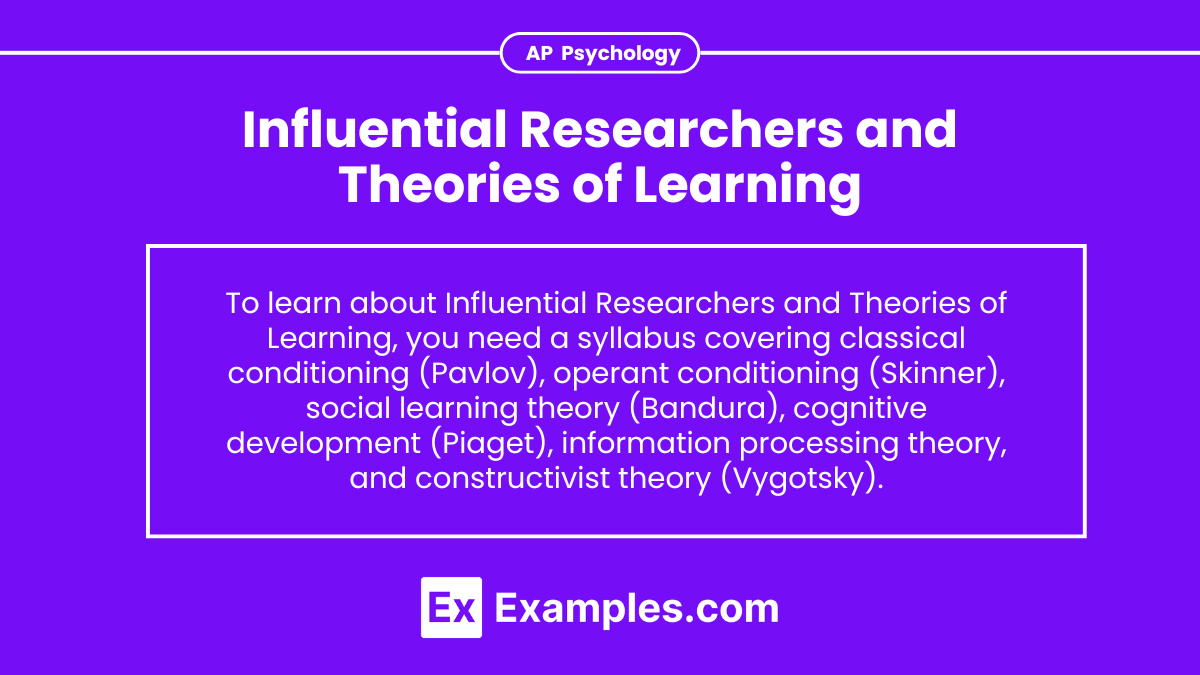Studying influential researchers and theories of learning is essential. Key figures like Ivan Pavlov, B.F. Skinner, Albert Bandura, Jean Piaget, and Lev Vygotsky have significantly contributed to our understanding of how learning occurs. In AP Psychology, their theories, including classical conditioning, operant conditioning, social learning theory, and cognitive development, offer diverse perspectives on behavior acquisition and change. Grasping these foundational concepts and experiments is vital for a comprehensive understanding of learning in psychology.
Learning Objectives
Understanding the foundational theories of learning and their key researchers. This includes classical conditioning (Ivan Pavlov), operant conditioning (B.F. Skinner), social learning theory (Albert Bandura), cognitive development theory (Jean Piaget), information processing theory, and constructivist theory (Lev Vygotsky). Learn the core principles, key experiments (e.g., Pavlov’s dogs, Skinner’s box, Bandura’s Bobo doll), and real-world applications of each theory to grasp how learning processes are studied and applied in psychology
1. Classical Conditioning (Ivan Pavlov)
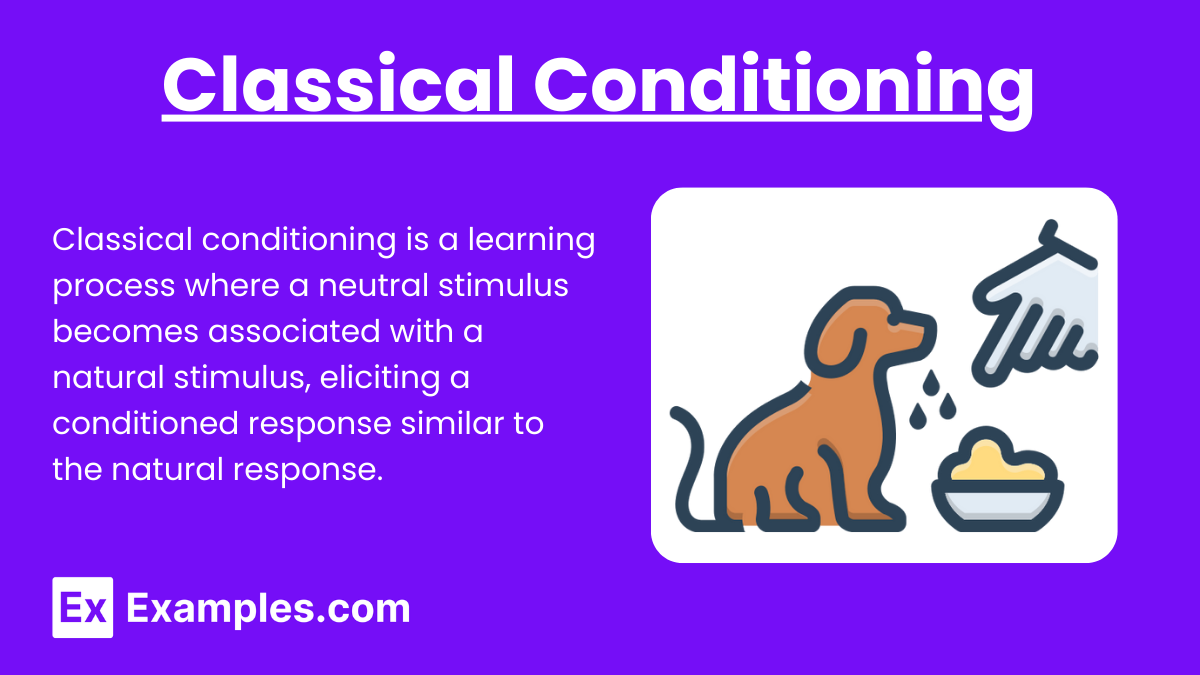
Classical conditioning, also known as Pavlovian or respondent conditioning, is a type of learning in which a previously neutral stimulus becomes associated with a stimulus that naturally elicits a response. This association leads to the neutral stimulus eliciting the same response on its own.
Key Terms
- Unconditioned Stimulus (UCS): A stimulus that naturally and automatically triggers a response without any prior learning (e.g., food).
- Unconditioned Response (UCR): The automatic, natural reaction to the unconditioned stimulus (e.g., salivation in response to food).
- Neutral Stimulus (NS): A stimulus that initially does not elicit any intrinsic response (e.g., a bell).
- Conditioned Stimulus (CS): A previously neutral stimulus that, after becoming associated with the unconditioned stimulus, eventually triggers a conditioned response (e.g., the bell after association with food).
- Conditioned Response (CR): The learned response to the previously neutral stimulus (e.g., salivation in response to the bell).
Pavlov’s Experiment
Ivan Pavlov, a Russian physiologist, discovered classical conditioning through his work on digestive processes in dogs. He noticed that dogs began to salivate not only when food was presented but also when they saw lab assistants who usually fed them. Pavlov designed an experiment to study this phenomenon systematically.
Experiment Steps
- Before Conditioning:
- Unconditioned Stimulus (UCS): Food
- Unconditioned Response (UCR): Salivation
- Neutral Stimulus (NS): Bell
- When the bell (NS) was presented, it elicited no salivation (no CR).
- During Conditioning:
- Pavlov rang the bell (NS) just before presenting the food (UCS).
- After several pairings, the dogs began to associate the bell with the food.
- After Conditioning:
- Conditioned Stimulus (CS): Bell
- Conditioned Response (CR): Salivation
- Now, the bell alone triggered salivation, demonstrating that the dogs had learned to associate the bell with the food.
Processes in Classical Conditioning
- Acquisition is the initial stage of learning when a response is first established and gradually strengthened. During acquisition, the neutral stimulus is consistently paired with the unconditioned stimulus until it becomes a conditioned stimulus. Conducting a feasibility study during this stage can help evaluate the effectiveness of the learning process and identify any necessary adjustments.
- Extinction occurs when the conditioned stimulus is repeatedly presented without the unconditioned stimulus, leading to the gradual weakening and eventual disappearance of the conditioned response. For example, if Pavlov rang the bell without presenting food repeatedly, the dogs would eventually stop salivating in response to the bell.
- Spontaneous recovery is the reappearance of a previously extinguished conditioned response after a rest period without new conditioning. If Pavlov allowed some time to pass after extinction and then rang the bell again, the dogs might briefly salivate, indicating that the conditioned response had not been entirely forgotten.
- Generalization occurs when stimuli similar to the conditioned stimulus also elicit the conditioned response. For example, if the dogs learned to salivate to a bell of a certain pitch, they might also salivate to bells of different pitches. This phenomenon can be studied through various research methodologies to understand the underlying processes..
- Discrimination is the ability to distinguish between the conditioned stimulus and other stimuli that do not signal an unconditioned stimulus. For example, the dogs could learn to differentiate between the specific bell that signals food and other bells that do not.
2. Operant Conditioning (B.F. Skinner)
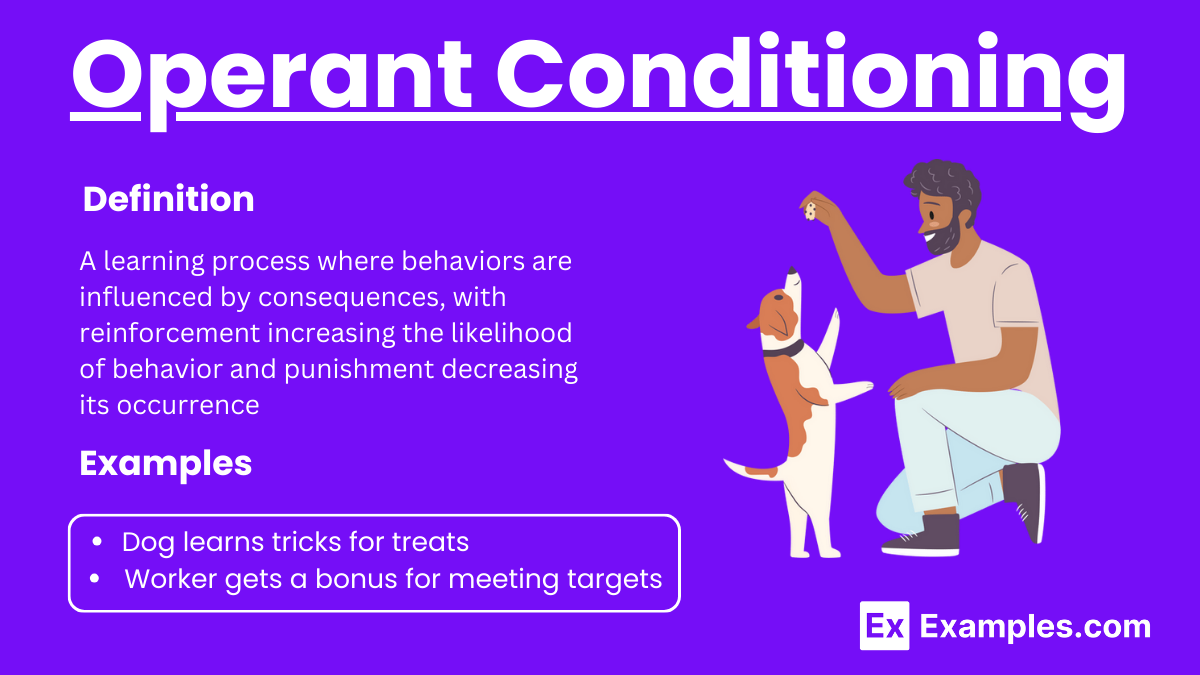
Operant conditioning, also known as instrumental conditioning, is a method of learning that occurs through rewards and punishments for behavior. It is based on the idea that behaviors are influenced by the consequences that follow them. This type of learning was primarily developed by B.F. Skinner.
Key Concepts
Reinforcement
Reinforcement is any event that strengthens or increases the likelihood of a behavior.
- Positive Reinforcement: Adding a pleasant stimulus to increase a behavior (e.g., giving a child candy for doing their homework).
- Negative Reinforcement: Removing an unpleasant stimulus to increase a behavior (e.g., taking painkillers to relieve a headache).
Punishment
Punishment is any event that decreases the likelihood of a behavior.
- Positive Punishment: Adding an unpleasant stimulus to decrease a behavior (e.g., scolding a dog for chewing on shoes).
- Negative Punishment: Removing a pleasant stimulus to decrease a behavior (e.g., taking away a teenager’s video game privileges for bad grades).
Skinner’s Experiments
B.F. Skinner conducted numerous experiments to study operant conditioning. One of his most famous tools was the Skinner box (operant conditioning chamber), which he used to study the behavior of animals, particularly rats and pigeons.
Skinner Box Experiment
- Setup: A Skinner box typically contains a lever (for rats) or a key (for pigeons) that an animal can press or peck.
- Reinforcement:
- Positive Reinforcement: When the animal presses the lever, it receives food. Over time, the animal learns to press the lever to get food.
- Negative Reinforcement: A mild electric current runs through the floor of the box, and the animal learns that pressing the lever turns off the current.
Schedules of Reinforcement
The frequency and timing of reinforcement can impact the rate and strength of the learned behavior. These are known as schedules of reinforcement.
- Fixed-Ratio (FR): Reinforcement after a set number of responses (e.g., a rat gets food every 10 lever presses).
- Variable-Ratio (VR): Reinforcement after an unpredictable number of responses (e.g., gambling, where the payout comes after an unpredictable number of plays).
- Fixed-Interval (FI): Reinforcement after a fixed amount of time (e.g., a paycheck every two weeks).
- Variable-Interval (VI): Reinforcement at unpredictable time intervals (e.g., checking your email at random times throughout the day).
3. Social Learning Theory (Albert Bandura)
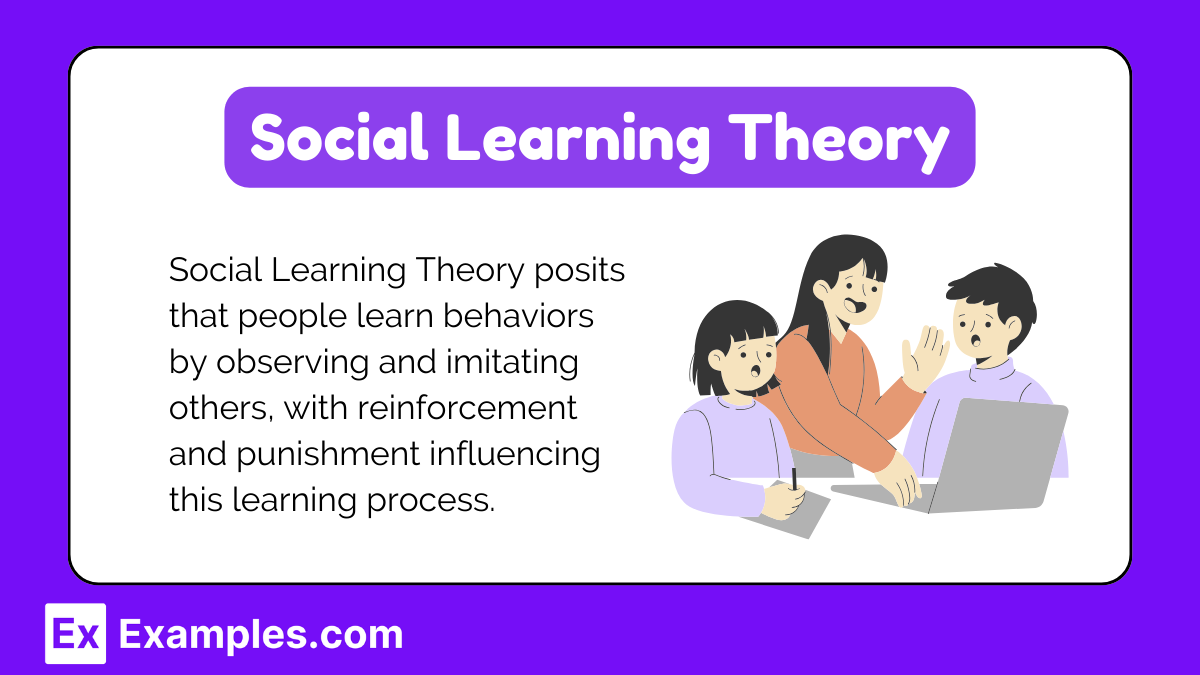
Social Learning Theory, developed by Albert Bandura, emphasizes the importance of observing, modeling, and imitating the behaviors, attitudes, and emotional reactions of others. It suggests that learning occurs in a social context and can happen purely through observation or direct instruction, even in the absence of motor reproduction or direct reinforcement.
Key Concepts
Observational Learning (Modeling)
Observational learning, also known as modeling, occurs when an individual observes and imitates another’s behavior. This process involves several key steps:
- Attention: The individual must pay attention to the behavior and its consequences. Attention can be influenced by the model’s attractiveness, competence, and status. Understanding these influences is crucial in studying biodiversity and how different species learn from one another.
- Retention: The individual must be able to remember the behavior. This involves storing the observed behavior in memory.
- Reproduction: The individual must have the ability to reproduce the observed behavior. This includes physical and mental capabilities.
- Motivation: The individual must have a reason to imitate the behavior. This can be influenced by anticipated rewards or punishments.
Bobo Doll Experiment
Albert Bandura’s Bobo doll experiment is one of the most famous studies in psychology, demonstrating the effects of observational learning.
Experiment Steps
- Participants: Children were divided into three groups.
- Procedure: Each group observed a different model:
- Aggressive Model: The model acted aggressively towards a Bobo doll (e.g., hitting, kicking).
- Non-Aggressive Model: The model played calmly and ignored the Bobo doll.
- Control Group: No model was shown.
- Observation: After observing the model, children were allowed to play in a room with a Bobo doll.
- Results: Children who observed the aggressive model were more likely to imitate aggressive behaviors, demonstrating that children can learn behaviors through observation alone.
Vicarious Reinforcement
Vicarious reinforcement occurs when individuals observe a model being rewarded or punished for a behavior, influencing the likelihood of the observer performing that behavior. If the model is rewarded, the observer is more likely to imitate the behavior. If the model is punished, the observer is less likely to imitate the behavior.
Self-Efficacy
Self-efficacy refers to an individual’s belief in their ability to succeed in specific situations or accomplish a task. Bandura suggested that self-efficacy plays a crucial role in how goals, tasks, and challenges are approached.
- High Self-Efficacy: Individuals with high self-efficacy are more likely to take on challenging tasks and persist in the face of difficulties.
- Low Self-Efficacy: Individuals with low self-efficacy are more likely to avoid challenging tasks and give up easily.
4. Cognitive Development Theory (Jean Piaget)
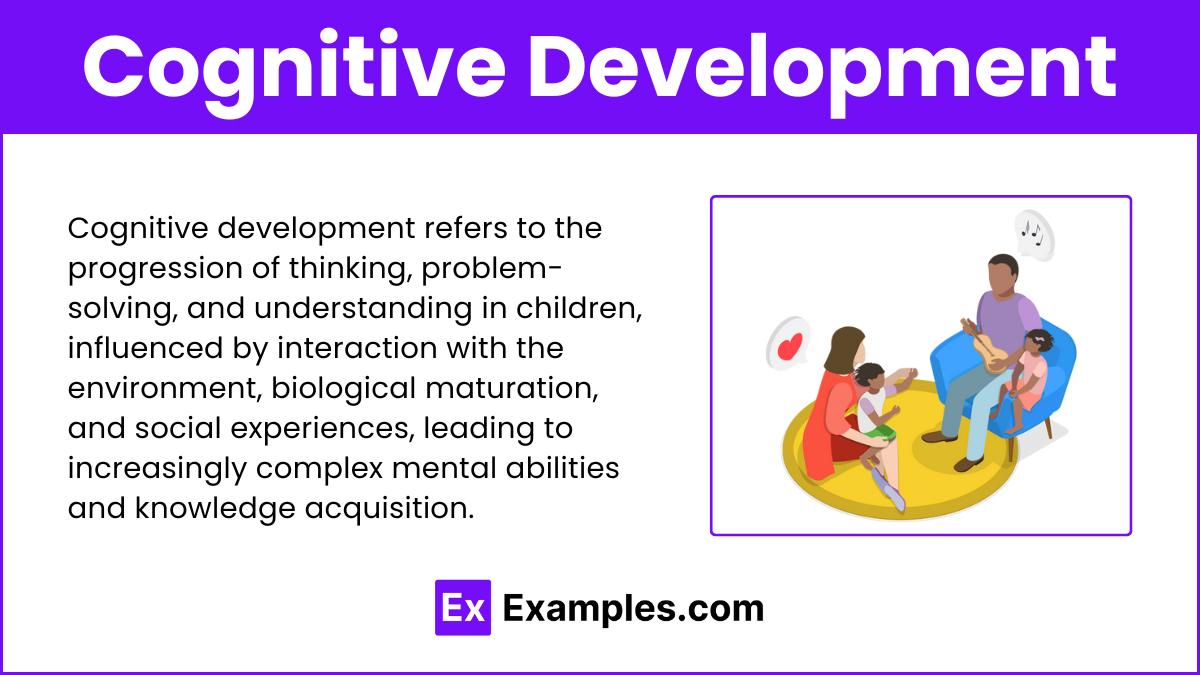
Cognitive Development Theory, proposed by Jean Piaget, describes how children develop logical thinking and reasoning skills over time. Piaget suggested that cognitive development occurs in stages, with each stage representing a different way of thinking and understanding the world.
Key Concepts
Schemas
Schemas are mental structures or frameworks that organize and interpret information. They are the basic building blocks of cognitive models and enable individuals to understand and respond to their environment.
- Assimilation: Integrating new information into existing schemas (e.g., a child seeing a zebra for the first time and calling it a horse).
- Accommodation: Modifying existing schemas or creating new ones in response to new information (e.g., a child learning that a zebra is a different animal from a horse and adjusting their schema accordingly).
Stages of Cognitive Development
Piaget identified four distinct stages of cognitive development, each characterized by different abilities and ways of thinking.
1. Sensorimotor Stage (0-2 years)
- Characteristics: Infants learn about the world through their senses and actions (e.g., looking, touching, mouthing).
- Key Milestones:
- Object Permanence: Understanding that objects continue to exist even when they are not seen (develops around 8-12 months).
- Goal-Directed Behavior: Performing actions with a particular purpose in mind.
2. Preoperational Stage (2-7 years)
- Characteristics: Children begin to use symbols (e.g., words, images) to represent objects but do not yet understand concrete logic.
- Key Features:
- Egocentrism: Difficulty in seeing things from perspectives other than their own.
- Animism: Belief that inanimate objects have lifelike qualities and feelings.
- Lack of Conservation: Inability to understand that quantities remain the same despite changes in shape or appearance.
3. Concrete Operational Stage (7-11 years)
- Characteristics: Children gain a better understanding of mental operations and start thinking logically about concrete events.
- Key Milestones:
- Conservation: Understanding that quantities remain the same despite changes in shape or appearance.
- Classification: Ability to group objects based on common features.
- Seriation: Ability to order objects by size, length, or other attributes.
4. Formal Operational Stage (12+ years)
- Characteristics: Adolescents develop the ability to think about abstract concepts and engage in hypothetical and deductive reasoning.
- Key Features:
- Abstract Thought: Ability to think about concepts that are not physically present.
- Hypothetical-Deductive Reasoning: Developing hypotheses and systematically deducing the best path to solve problems.
Processes of Cognitive Development
- Equilibration: The process of balancing assimilation and accommodation to create stable understanding.
- Disequilibrium: A state of cognitive imbalance when new information cannot be fitted into existing schemas, prompting cognitive development.
5. Information Processing Theory
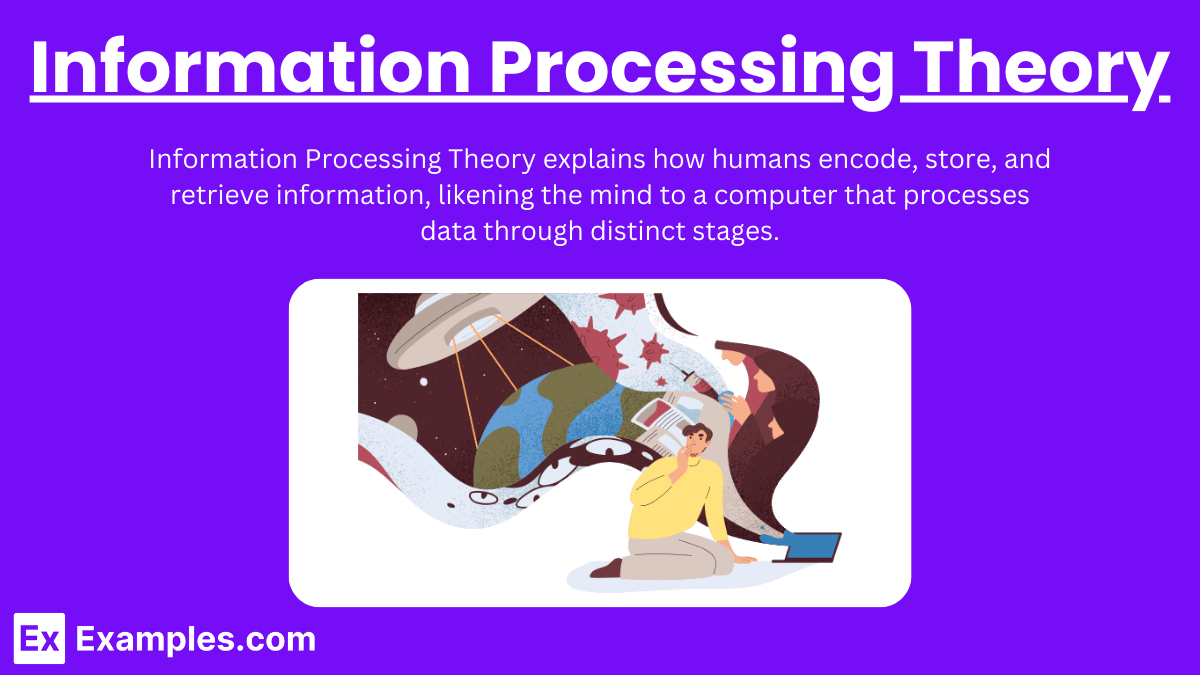
Information Processing Theory compares human cognition to computer processing, emphasizing how information is encoded, stored, and retrieved. This theory focuses on the mechanisms through which learning occurs, describing the detailed processes involved in processing information.
Key Concepts
1. Stages of Information Processing
Encoding
Encoding involves transforming sensory input into a form that can be stored in memory. It is the first step in creating a memory.
- Types of Encoding:
- Visual Encoding: Encoding images and visual sensory information.
- Acoustic Encoding: Encoding of sounds, particularly the sounds of words.
- Semantic Encoding: Encoding of meaning, including the meaning of words.
Storage
Storage refers to maintaining information over time. Information must be stored to be available for retrieval later.
- Types of Memory Storage:
- Sensory Memory: The shortest-term element of memory, which holds sensory information for a few seconds or less.
- Short-Term Memory (STM): Holds a limited amount of information temporarily (about 20-30 seconds). Also known as working memory.
- Long-Term Memory (LTM): Holds information indefinitely. It has potentially unlimited capacity.
Retrieval
Retrieval is the process of accessing stored information when it is needed.
- Retrieval Processes:
- Recall: Retrieving information without cues (e.g., answering an essay question).
- Recognition: Identifying previously learned information from a set of options (e.g., multiple-choice questions).
- Relearning: Learning information again that was previously learned and then forgotten.
2. Models of Information Processing
Atkinson-Shiffrin Model (Multi-Store Model)
The Atkinson-Shiffrin Model describes memory as consisting of three distinct stores: sensory memory, short-term memory, and long-term memory.
- Sensory Memory: Holds sensory information for a brief period (e.g., visual information for less than a second).
- Short-Term Memory: Limited capacity (7±2 items) and duration (20-30 seconds).
- Long-Term Memory: Unlimited capacity and duration.
Baddeley and Hitch’s Working Memory Model
This model expands on the concept of short-term memory by introducing the idea of working memory, which consists of multiple components:
- Central Executive: Controls attention and coordinates activities of the other components.
- Phonological Loop: Deals with auditory information and preserves the order of auditory data.
- Visuospatial Sketchpad: Deals with visual and spatial information.
- Episodic Buffer: Integrates information from different sources and maintains a sense of time, linking information across domains.
3. Cognitive Load Theory
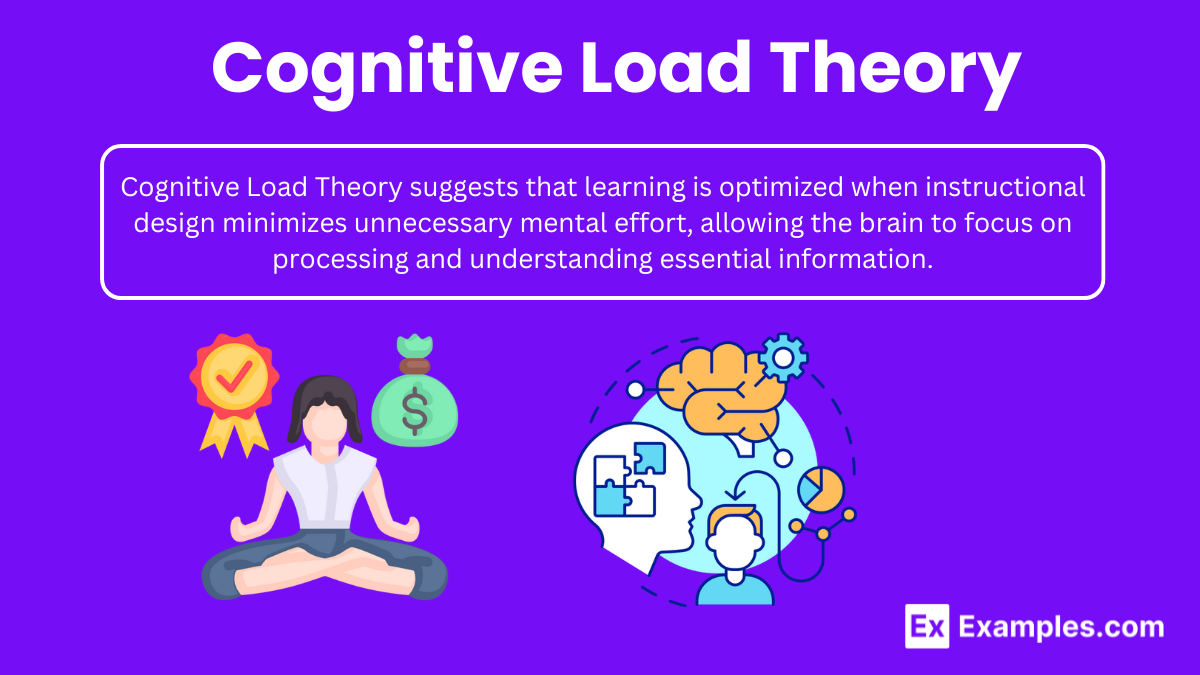
Cognitive Load Theory focuses on the amount of mental effort being used in the working memory. It differentiates between three types of cognitive load:
- Intrinsic Load: The inherent difficulty of the material being learned.
- Extraneous Load: The way information or tasks are presented to learners, which can either facilitate or hinder learning.
- Germane Load: The mental effort required to process, construct, and automate schemas.
6. Constructivist Theory (Lev Vygotsky)
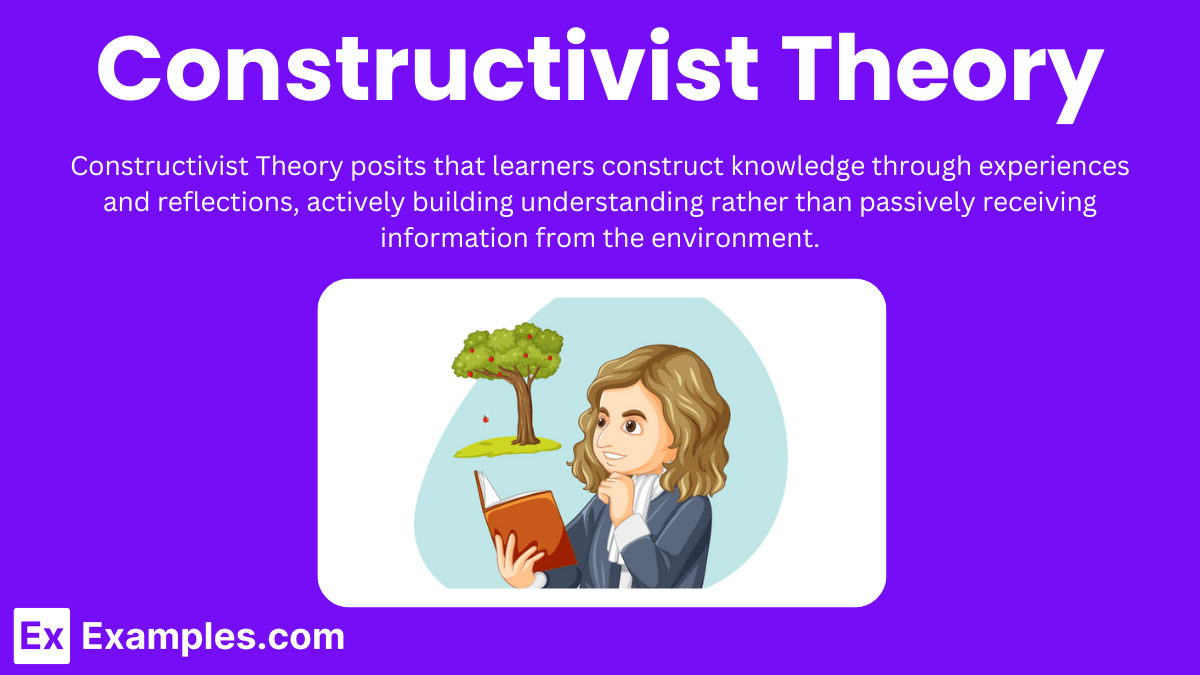
Constructivist Theory emphasizes that learning is an active, constructive process where learners build new knowledge upon the foundation of previous learning. This theory, rooted in the works of Jean Piaget and Lev Vygotsky, posits that learners are not passive recipients of information but active participants in their own learning process.
Key Concepts
Jean Piaget’s Constructivism
Jean Piaget’s theory of cognitive development is foundational to constructivism. He proposed that children construct their own understanding and knowledge of the world through experiences and reflecting on those experiences.
Piaget’s Stages of Cognitive Development
- Sensorimotor Stage (0-2 years):
- Learning through sensory experiences and actions.
- Development of object permanence.
- Preoperational Stage (2-7 years):
- Use of symbols and language.
- Egocentrism and lack of conservation.
- Concrete Operational Stage (7-11 years):
- Logical thinking about concrete events.
- Understanding of conservation and classification.
- Formal Operational Stage (12+ years):
- Abstract and hypothetical thinking.
- Deductive reasoning and problem-solving.
Lev Vygotsky’s Social Constructivism
Lev Vygotsky’s social constructivism emphasizes the role of social interactions and cultural tools in the development of cognition. He introduced several key concepts:
Zone of Proximal Development (ZPD)
The Zone of Proximal Development (ZPD) is the difference between what a learner can do independently and what they can do with guidance and support from a more knowledgeable other (MKO).
Scaffolding
Scaffolding involves providing temporary support to a learner that is tailored to their needs and gradually removed as the learner becomes more proficient.
More Knowledgeable Other (MKO)
The More Knowledgeable Other (MKO) is anyone who has a better understanding or a higher ability level than the learner, with respect to a particular task, process, or concept. This could be a teacher, parent, peer, or even technology.
7. Behavioral Theories of Learning
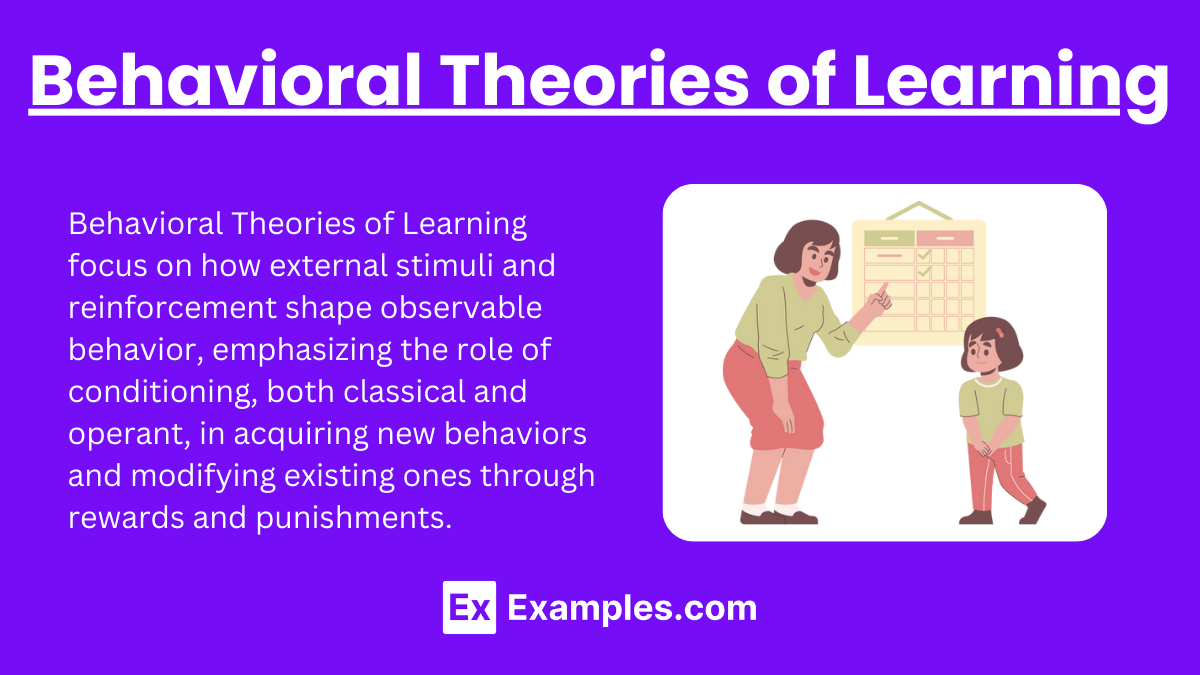
Behavioral theories of learning focus on observable behaviors and the processes by which behaviors are acquired, changed, or extinguished. These theories emphasize the role of environmental stimuli and responses in shaping behavior, and they largely ignore internal mental states. Key figures in behavioral learning theories include John Watson, Ivan Pavlov, B.F. Skinner, and Edward Thorndike.
Key Concepts
Classical Conditioning (Ivan Pavlov)
Classical conditioning is a learning process that occurs through associations between an environmental stimulus and natural resources as naturally occurring stimuli.
- Unconditioned Stimulus (UCS): A stimulus that naturally and automatically triggers a response (e.g., food).
- Unconditioned Response (UCR): The natural response to the UCS (e.g., salivation in response to food).
- Neutral Stimulus (NS): A stimulus that initially does not trigger any intrinsic response (e.g., a bell).
- Conditioned Stimulus (CS): The previously neutral stimulus that, after association with the UCS, triggers a conditioned response (e.g., the bell after being paired with food).
- Conditioned Response (CR): The learned response to the previously neutral stimulus (e.g., salivation in response to the bell).
Operant Conditioning (B.F. Skinner)
Operant conditioning is a method of learning that occurs through rewards and punishments for behavior. This type of learning is based on the consequences of actions.
- Positive Reinforcement: Adding a pleasant stimulus to increase a behavior (e.g., giving a child candy for doing their homework).
- Negative Reinforcement: Removing an unpleasant stimulus to increase a behavior (e.g., taking painkillers to relieve a headache).
- Positive Punishment: Adding an unpleasant stimulus to decrease a behavior (e.g., scolding a dog for chewing on shoes).
- Negative Punishment: Removing a pleasant stimulus to decrease a behavior (e.g., taking away a teenager’s video game privileges for bad grades).
Thorndike’s Law of Effect (Edward Thorndike)
Edward Thorndike’s Law of Effect states that behaviors which result in a satisfying increase in pulse rate are more likely to be repeated, while behaviors followed by an unpleasant increase in pulse rate are less likely to be repeated.
Watson’s Behaviorism (John Watson)
John Watson, the founder of behaviorism, emphasized the study of observable behavior and rejected the study of mental processes. He believed that all behavior is learned and shaped by the environment.
Little Albert Experiment
Watson and Rosalie Rayner conducted the Little Albert experiment to demonstrate that emotional responses could be conditioned in humans.
- Experiment: An 11-month-old baby named Albert was exposed to a white rat, initially showing no fear. Each time Albert reached for the rat, Watson and Rayner made a loud, frightening noise behind his head. After several pairings, Albert began to cry and show fear at the sight of the rat alone, demonstrating that fear could be conditioned.

